Practical Action/Ventilated Improved Pit Latrine
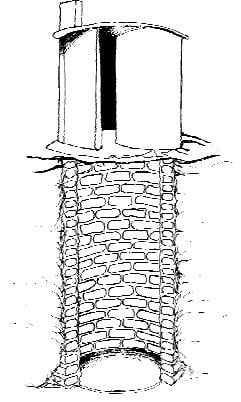
The ventilated improved pit " V.I.P " latrine offers improved sanitation by eliminating flies and smell, through air circulation. The addition of a chimney draws air currents into the structure and through squat hole. Odours rise through the chimney and disperse. The structure of the toilet means that any flies attracted to the pit through the squat hole will try to escape by heading towards the strongest light source, which comes from the chimney. The flies exit is blocked by a wire mesh so the flies eventually die and fall back into the pit. The spiral structure prevents too much light entering the toilet while allowing a free flow of air.
Introduction [edit | edit source]
Hygiene is obviously an important issue wherever the toilet is located but more so where there are many users. Faecal-borne diseases take more lives and create more suffering than war or natural disaster, but do attract as much media coverage. Due to the number of fatalities, it is important to consider hygiene and cleanliness. A dirty latrine is not only unpleasant to use, especially bare foot, but smells and attract flies, bringing more diseases. The number of flies can be reduced by using a ventilated improved pit latrine.
If the latrine is well designed then there should be less concern for disease as the latrine will be easy to clean, (clean-able floor and surfaces), as well as including a sanitary plate (SanPlat) or pour-flush system. The solution, to better use of latrines is simple, and depends on the three factors of sanitation, water supply and hygiene education.
There are many types of latrine, which already exist, constructed in a variety of ways from different materials. Depending upon the environment and the number of users, the design of a latrine is altered to suit the needs of the users.
There are many questions that can be asked before constructing a latrine, below are some you may want to think about:
- What type should be built? – Where is it being built and who is going to use it? Private or community?
- How complicated is it to build or use? – What materials and labour are needed? Are they on location or do specialists need to be contacted?
- What are the problems related to the different types of latrines? – As discussed hygiene is the biggest issue. What other problems may arise – sanitation, location?
Main types of latrines[edit | edit source]
- Traditional pit latrines – Well known in Africa, Asia and Latin America. A simple pit covered with logs. Not usually roofed, sometimes they have no walls. Cost zero, no specialist skills
- SanPlat latrines – like the traditional latrine but with a SanPlat, slightly elevated for ease of use in the dark. Can be located close to house with fitted lid to prevent smell and flies.
- Conventional improved pit latrines – Again similar to the traditional latrine, but built with more solid materials, i.e. bricks, with walls and a roof. Putting hot ashes in the latrine can reduce smell and flies.
- VIP latrines – Consisting or the normal pit but with a screened vent pipe fitted. Wind ideally blows over the vent pipe.
- Pour-flush latrines – Common in southern Asia. Water seal fitted to drop hole, meaning no smell and no flies. Water is poured into the water seal to flush the toilet. Problems could be the water supply and fitting the seal.
- Compost Latrines -The idea of this is to build a permanent latrine with removable pits, to use the contents for fertiliser. 60 litres per person per year. Shallow excavation, but high cost, due to the double pit lining.
Construction[edit | edit source]
The VIP Latrine can be built from different materials. These should be chosen according to availability and cost of materials, skills available, and soil type. If the soil of the ground is very loose, it is recommended to use a lighter materials for the walls. The different materials that can be used require alternative methods of construction. In all cases, the slab is built the same and a chimney higher than the roof is constructed. This technical brief describes the construction of a mortared brick design because it is the most popular. The main materials for this latrine are; sand, gravel, bricks, bags of cement, wire mesh, chicken wire, water.
Tools needed[edit | edit source]
Tape measure, shovels, masonry trowels, wooden floats, buckets, karias, pliers, pombo, panga or old chisel and hammer, plastic sheeting, woven plastic sugar sacks, sisal twine, large canvas sewing needles.
Siting[edit | edit source]
Choose firm soil with good drainage. It should be made in a convenient location, at least 40 meters away from any springs, streams or rivers. Note the direction of prevailing winds. Latrines should be placed downwind of the home or school. The doorway of the VIP latrine should face the wind.
Excavation[edit | edit source]
Mark a circle in the ground using 2 sticks and a string as shown. For a family latrine, the circle should be 1.5 metres (5 feet) across, so the string should be 75 cm long between the two sticks. For a school or community latrine, the diameter should be 1.8 metres across, so the string should mark a radius of 90-cm (3 feet) If the ground is quite rocky and very stable during rains, then the brick lining may be eliminated. In such cases reduce the radius (the length of the string) by 15cm.
Do not make the hole too wide, you can endanger the occupants.
Dig the hole 3 meters, (10 feet) deep. Be careful to keep the walls straight.
Foundation[edit | edit source]
- Begin laying and mortaring courses of bricks at the bottom of the pit. Alternate vertical joints in the bricks. Do not lay bricks or plaster over the floor of the pit, and do not mortar vertical joints.
- Continue building up the wall of the pit.
- When you reach the top layer, dig out a little wider and lay the last row of bricks perpendicular, as shown. Mortar the vertical joints in this row.
Most soils considerably soften during the rainy season. Due to its weight, a brick superstructure is in danger of collapsing without a strong foundation as described here.
The alternative is to build a light superstructure. Very light superstructures, such as these, made from thin wattle and daub, with grass roofs, should not require such a strong foundation. Consult with a good carpenter or mason on how to assure a strong and suitable foundation that takes into account the soil type and the materials used in building. In any case, the top layer of bricks described here should be laid and the top half of the pit should be plastered with mortar.
Slab[edit | edit source]
- For a 1.2m (4ft) diameter hole, make a 2.15m (7ft) diameter slab.
- For a 1.5m (5ft) diameter hole, make a 2.4m (8ft) diameter slab.
- This gives a stable 45 cm overlap to the hole.
Next to the latrine, dig a hole in which to cast the slab. It should have a diameter, which is 90-cm larger than the mortared latrine pit, and a depth of 7.5cm. The floor should be very smooth.
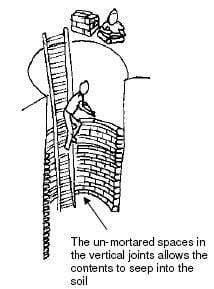
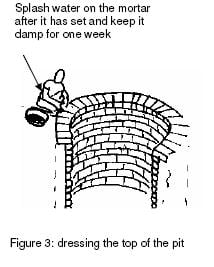
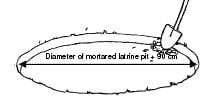
Splash water on the mortar after it has set and keep it damp for one week.
If the soil is to rocky to make a smooth floor, in the shallow hole, then build a form using lumber, or place a sheet of polythene plastic within a circle of bricks.

Carve two forms (from either wood or brick) as shown. They should be at least 7.5 cm thick. They will be used to cast the squat hole and the chimney hole in the slab. The chimney form can either be round or square.

To add strength to the floor slab, weld mesh is set into the centre of the concrete slab. You need to cut and tie together pieces of 2" weld mesh (or BRC weld mesh) to fit inside the shallow hole. Where the formers are positioned, for the chimney and squat hole, you need to remove some of the mesh to leave room for the formers to be released. Mark the ground where the forms go, and leave them in place.
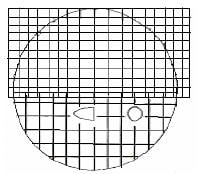
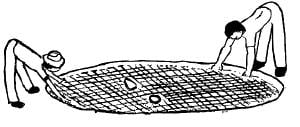
Then removing the wire mesh carefully and leaving the forms in place, you should be able to cast a reinforced concrete slab. Mix enough concrete to fill the hole in the proportions; 1 part cement; 2 parts sand; 4 parts gravel. Add just enough water to shovel the concrete. With the squat and chimney hole form in place, pour about one third of the concrete into the smooth, shallow hole. Using the pimbo, pound down a layer 2.5 to 3cm thick. Use a clean nail to check the thickness. Insert it, then remove it and measure the cement marks.
Then lay the cut wire mesh on top of the concrete. Check to see that the hole forms are still in their proper places. Adjust if necessary so that the weld mesh wires do not quite touch the forms. Then pour a second layer of concrete 4.5 – 5cm thick, onto the reinforcement. Trowel it flat. After it has set, splash water on the concrete and cover it with plastic sheeting. Keep it damp and covered with plastic for 7 days. After the concrete has dried, cover the pit with the slab.
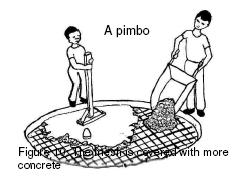
Walls[edit | edit source]
Lay down the first course of bricks very carefully. Then mortar underneath and between the bricks.
Alternate the vertical joints of courses of bricks and continue up to 2 meters (6.5 ft) high. Mortar in place the flyscreen just below the chimney should be two bricks higher than the top of the roof.
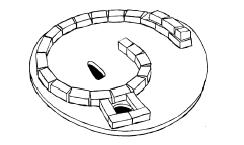
If you have chosen a roof of corrugated iron, tiles or a concrete slab, then lay bricks higher toward the chimney to support the slant of the roof.
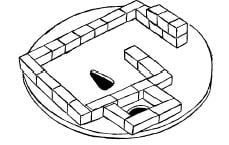
Plaster over the inside wall to encourage reflecting light. If desired, plaster the outside wall as well.
Roof[edit | edit source]
Coned Roof[edit | edit source]
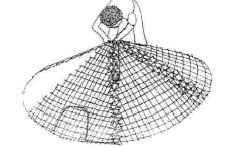
Measure the top of the wall at the widest part. Draw a circle in the ground that has the same diameter. Cut 5 triangles like the one below from wire mesh. Tie them together, using 16 gauge binding wire, so that they fit in the circle. Overlap the sides by 30cm. When the 5 are tied together, measure and cut the 6th triangle, including overlap. Tie it in place. Wrap 1 or 2 layers of chicken wire onto the wire mesh and bind them tightly.
Turn the reinforcement upside down and sew plastic sugar sacks onto the inside. Use sisal twine, and sew stitches 10 – 15 cm in length, starting at the rim. Then place the roof reinforcement on top of the wall.
Measuring very carefully mix a batch of 1:3 (cement, sand) plaster. It should not be too wet. Trowel on a layer of plaster, pushing it lightly into the chicken wire. Once the plaster has set, throw water onto the roof and then cover with plastic. Puts on a second coat of plaster the next day and trowel it smooth. It is essential that all wires be covered with plaster. Smooth the edges of the roof to make an attractive bond with the wall.
Again cover with plastic once the plaster has set. Keep the plaster damp for 3 to 7 days. In the afternoon of the same day cut the twine and remove the sugar sacks from inside the roof. Throw a thin layer of 1:3 (cement, sand) plaster onto the ceiling. Cover all of the reinforcement wires. This ensures a strong and durable roof.
Concrete Slab[edit | edit source]
The concrete slab is made in a similar way to the slab base. You need to build up bricks higher towards the chimney to create a slant for the roof, for drainage.
You may be able to use the same hole you created for the slab base, but in some cases you may need to dig a new one. The slab for the roof need only be 2.5 cm thick, but you need to allow for an overhang in the diameter. This is why you could use the base hole to construct your roof.
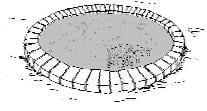
Once you have created the hole you will need to put some other moulds in for the space where the chimney will be located. Once you have checked the measurements and everything is set out correctly, complete the slab in Figure 14: casting a flat roof from the same way as the base. You still concrete need to reinforce the slab but this time only with chicken wire.
Tiled and corrugated roofs[edit | edit source]
The corrugated roof is probably the easiest to construct and will last a long time, along with the tiles. Like the concrete slab you will need to build the bricks up on the chimney side to create a slant for drainage.
You will need some support pieces of wood to hold the tiles or corrugated sheet. The length of theses will vary depending on your structure, but it is again important to note you will need to allow for an overhang. When you have your beams fixed then you can begin to lay your sheet or your tiles.
You must make sure that they are both fixed down correctly using suitable fixings depending on your structure. The corrugated sheets need have good overlaps between them, as do the tiles. You don't want the roof to leak. Depending on your tiles or corrugated iron you may need to seal them as required.
Finishing the roof[edit | edit source]
Once the roof is complete you are ready for finishing. For the cone roof and the concrete slab roof, keep the roof damp for about a week. Splash water on it and keep covered with plastic. When the latrine has dried you can paint if desired.
For the corrugated and tiled roofs, there may be gaps between the wall and the roof, which may be filled with mortar. This is to stop the light getting in and so deterring flies from coming up the latrine. Paint the inside of the wall white to make it very easy to see when inside.
References and further reading[edit | edit source]
- Esrey S Et al. Ecological Sanitation. Sida, Stockholm, 1998
- Reed R.A. Sustainable Sewerage. Intermediate Technology Publications, London. 1995
- Brandberg B. Latrine Building: A handbook for implementation of the SanPlat system. Intermediate Technology Publications, London. 1997
- Laver S. Blair Latrines Builders Instruction Manual. Blair Research Laboratory.
- Ryan B.A Et al. Ventilated Improved Pit Latrines: Vent Pipe Design Guidelines. The World Bank, Washington.1983
- Morgan P.R Et al. Ventilated Improved Pit Latrines: Recent Developments in Zimbabwe. The World Bank, Washington, 1982
This Technical Brief by Simon Farmer is based on the Ventilated Improved Pit Latrine Construction Manual produced by UNICEF Technology Support Section, Kenya